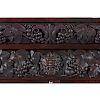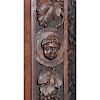Cincinnati Art-Carved Cabinet by Henry and William Fry
About Seller
6270 Este Ave.
Cincinnati , OH 45232
United States
With offices in Cincinnati, Cleveland and Denver, Cowan’s holds over 40 auctions each year, with annual sales exceeding $16M. We reach buyers around the globe, and take pride in our reputation for integrity, customer service and great results. A full-service house, Cowan’s Auctions specializes in Am...Read more
Two ways to bid:
- Leave a max absentee bid and the platform will bid on your behalf up to your maximum bid during the live auction.
- Bid live during the auction and your bids will be submitted real-time to the auctioneer.
Bid Increments
| Price | Bid Increment |
|---|---|
| $0 | $25 |
| $500 | $50 |
| $1,000 | $100 |
| $2,000 | $250 |
| $5,000 | $500 |
| $10,000 | $1,000 |
| $20,000 | $2,500 |
| $50,000 | $5,000 |
| $100,000 | $10,000 |
About Auction
Jun 8, 2019
This summer, Cowan's is offering two Fine and Decorative Art, Including Americana live auctions: On Saturday, June 8, the Premier Auction features over 450 lots of fine art, furniture, silver, rugs, glass, Folk Art, and advertising. Cowan's Auctions dawnie@cowans.com
- Lot Description
American (Cincinnati), ca 1860s. A Cincinnati art-carved cabinet in walnut with oak secondary, carved by Henry Lindley Fry (1807-1895) and William Henry Fry (1830-1929), the upper case having a projecting cornice, two beveled glass doors opening to reveal three adjustable shelves, over a lower case with one dovetailed drawer, raised on cabriole legs and lion’s-paw feet. The whole with hand-carved decorations of grapes, grapevines and grape leaves, stylized rosettes, leaves and two figural heads; ht. 89.5, wd. 55, dp. 26 in.
This exquisite and monumental cabinet descended in the family of Patrick M. Flannery, a prominent attorney in Covington, Kentucky. Flannery acquired the cabinet (and two other Fry-carved pieces of furniture) from the estate of United States Senator Richard P. Ernst (1858-1934) when he purchased Ernst’s home at 405 Garrard Street in Covington in 1937. From 1954 until recently the cabinet was an arresting presence at the Flannery home on Riverside Drive in Covington.
The cabinet was most certainly carved by Henry L. Fry and his son William H. Fry. The abundance of skillfully carved naturalistic motifs and the eclectic Italianate style of the piece closely resemble the work of the Frys. Additionally, the overall decorative treatment of the cabinet has distinct links to the eminent Longworth family of Cincinnati, a family who was instrumental in the success of the Frys' carving business. Henry and William Fry’s importance extended beyond their individual commissions to their roles as teachers and they are credited with launching one of the most important manifestations of the Aesthetic movement in the United States, the Cincinnati art-carved furniture movement.
The Frys were originally from Bath, England, where Henry completed an apprenticeship in carving. He maintained a business as a cabinet carver in Cheltenham, England in the late 1830s and 1840s. Fry was a highly accomplished craftsman, adept at carving in a multitude of styles and woods. He specialized in large domestic and ecclesiastical furnishings and was fluent in the fashionable styles of the period, such as Gothic revival, Elizabethan, Italianate, and Renaissance revival. Eventually, he taught his son William the art of carving.
Henry and William immigrated to the United States in 1849. By way of New Orleans, they arrived in Cincinnati in 1851. By the 1850s, Cincinnati, with its rapidly growing population and wealth, supported the endeavors of numerous craftsmen including silversmiths and furniture manufacturers. The city had become one of the most important centers in the United States for the production of furniture. It was in this booming industrial city that the Frys established a woodcarving studio, and soon gained local and national recognition for their work.
One of the Frys’ most important patrons was the prominent Cincinnatian Joseph Longworth. In the late 1850s, the Frys carved the interior of Rookwood, Longworth’s country villa, which included an exquisite mantel, now in the collections of the Cincinnati Art Museum.
Henry Fry wrote about the project,
“Our Work in Mr. Longworth’s house is pretty well known, as while we were working on the premises he brought us many visitors. He gave us a carte blanche to do what we thought best. Certainly we tried and the public has given us the credit of doing it.”
The mantel’s grapevine motif pays tribute to Joseph Longworth’s father, Nicholas, who introduced viticulture to the United States and owned one of the first successful vineyards in the country. Nicholas Longworth was a lawyer who through real estate investment became one of the wealthiest men in the United States.
The grape and grapevine motif is further celebrated on this cabinet currently on offer. With its intricately carved grapes, vines and leaves in high relief, the piece likely was carved for the Longworth family, and, as the mantel from the Rookwood estate, likely commemorates the accomplishments and ingenuity of Nicholas Longworth, the family’s patriarch. Additionally, this representational carving reflects the Victorian fascination with nature and in effect brings the out-of-doors into the home. Here, this medley of naturalistic motifs is juxtaposed with the two figural carvings of children’s heads flanking each door and the lion’s-paw feet that support the cabinet. Low-relief carving of stylized rosettes and idealized flowers provide further visual interest. The cabinet demonstrates the Frys’ skill in uniting naturalistic, figural, and geometric elements successfully in one work, and shows their adherence to the Italianate style.
After work was completed on Joseph Longworth’s estate, he commissioned the Frys to carve the interior of another home on his property. This home was a wedding gift for his daughter Maria Longworth, later the founder of The Rookwood Pottery Company, at the time of her marriage to George Ward Nichols.
The Frys and their assistants worked on the house from 1868 to 1872, during which time they created a rich interior of carved ceilings, archways, woodwork, and corner cupboards, all of which display a wealth of naturalistic elements. Soon after this commission was completed Henry and William Fry began to offer courses in woodcarving at their studio. Their efforts, along with fellow British ex-patriot Benn Pitman, are credited with sparking a woodcarving craze in Cincinnati in the 1870s. The Frys and Pitman and their students, primarily affluent women seeking a suitable artistic pastime, gained national acclaim for their woodcarving through their displays at the Philadelphia Centennial Exhibition of 1876 and the World’s Columbian Exposition in Chicago in 1893.
Although the appeal of woodcarving had waned by the end of the nineteenth century, both Henry and William Fry maintained successful careers until their deaths. Today, their work can be found in museum collections, the homes of descendants of the woodcarvers, and the homes of knowledgeable and passionate collectors. This cabinet is not only a tour de force of the Cincinnati art-carved furniture movement, it also exemplifies the unparalleled skill of the Frys and stands as an enduring tribute to the nationally significant artistic movement they helped found.
For more information on Henry and William Fry and the Cincinnati woodcarvers, see Jennifer L. Howe, editor, Cincinnati Art-Carved Furniture and Interior s (2003). - Shipping Info
-
Buyers are required to pay for all packing, shipping and insurance charges. Overseas duty charges are the responsibility of the successful Bidder. Be aware that for larger and/or valuable items, shipping charges can be substantial. - If there is no shipping amount on listed your invoice, you will need to make arrangements to pick up or ship your purchase through an alternative shipping company. Our shipping department can be contacted at 513.871.1670 (ext. 219) or email shipping@cowans.com. - Shipping charges include insurance for your order while in transit. If you have private insurance we will adjust your charge to include only packing and shipping. - Please allow 14 – 21 days after payment to package and ship your purchase as carefully as possible.
-
- Buyer's Premium



 EUR
EUR CAD
CAD AUD
AUD GBP
GBP MXN
MXN HKD
HKD CNY
CNY MYR
MYR SEK
SEK SGD
SGD CHF
CHF THB
THB



























